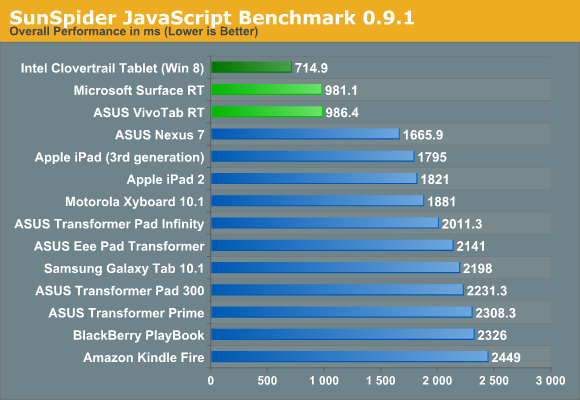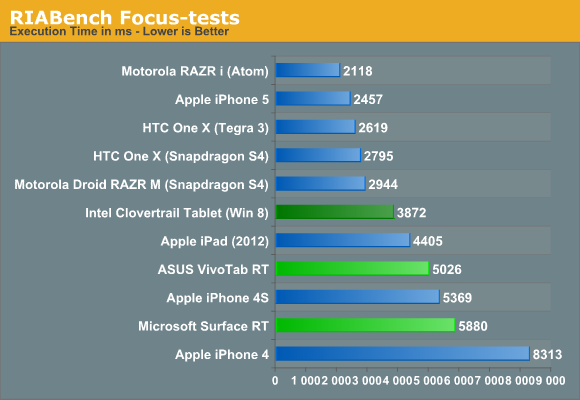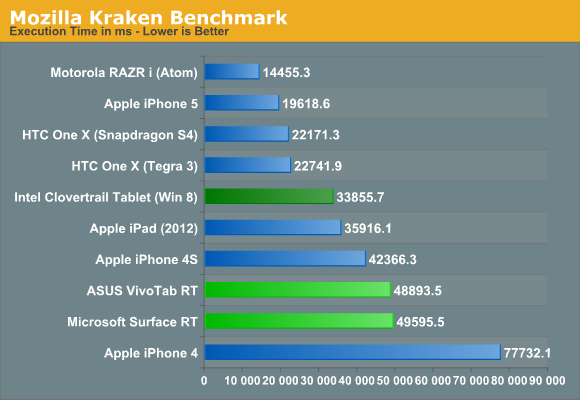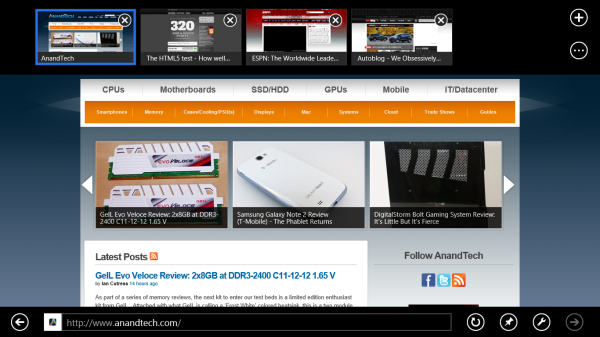The Windows RT Review
by Vivek Gowri & Anand Lal Shimpi on October 25, 2012 12:00 PM EST- Posted in
- Windows RT
- Operating Systems
- Microsoft
- Mobile
- Windows 8
- Tablets
Internet Explorer 10
There are two distinct versions of Internet Explorer 10 - one that runs in the desktop and looks very similar to the IE9 and IE10 experiences that we’ve been used to on the Windows 7/Windows 8 desktop, and another that runs within the framework of Modern UI and looks like an upscaled version of IE9 Mobile from Windows Phone 7.5 Mango. Both use the same rendering engine and perform identically, so we’ll keep that in mind when looking at performance numbers. Other than the user interfaces, there’s relatively little difference between the two browsers, though you will need to open the desktop IE10 to change browser settings - there's no way to do so from within Modern UI.
Gestures in the Modern UI version of IE are very important - swiping from the top or bottom brings up the URL bar at the bottom and the thumbnail list of open tabs at the top. It looks great, and keeps the webpage completely clean, but I don’t think the tabbed browsing implementation here is that great - I’d rather see something like Chrome or Safari with the list of open tabs always displayed at the top of the window. Changing tabs requires an extra step (swipe, then select), which isn’t ideal for changing between tabs quickly. If you deal with a lot of open tabs, or have some need to flip between two specific tabs repeatedly, this will get annoying relatively swiftly. It still looks great, and for touch-based browsing it works quite well other than the concerns over tabbed browsing. The “fancy” version of IE10, as Anand called it, strikes me as a very idealistic design philosophy that doesn’t necessarily work as well as a less elegant interface might.
One feature that works very well but could use some performance tuning is the back/forward touch navigation for Modern UI's IE10. To go back a page just swipe from left to right (or right to left to go forward). It's incredibly intuitive. My only complaint? Although going back immediately shows you the previous page, you have to wait for the page to actually re-render before it's usable (which on present day ARM hardware isn't exactly fast). I suspect this is something that will become far more useful over time with faster SoCs.
The desktop IE10 is just desktop IE, you’ve seen this before. Nothing that new, the UI looks pretty similar to IE9 (which is the first version of IE I can remember enjoying, though it will never replace Chrome in my heart) and it functions similarly as well. Obviously, there’s an updated rendering engine, but other than that and a new scrollbar design to match the rest of the Modern UI visual style, there’s not much to see here.

The most interesting part, actually, is in the settings - you can set links to default open in Fancy IE10, the desktop IE10, or let IE decide which to use on a contextual basis. You can also have the IE10 tile in Modern UI to open the desktop IE10, so you can basically ignore the new IE10 UI entirely should you want to do so. Now, I suspect this option exists primarily for desktop and notebook users of Windows 8, who don’t want to deal with using the Fancy IE10 interface with a mouse input. But it’s there for Windows RT users who want to use only the desktop IE10 UI. Personally, I wouldn’t want to use the classic interface in touchscreen devices - UI elements are damn small at this pixel density, making it more difficult to hit the right buttons than it needs to be. There’s a reason the Modern UI variant of IE10 exists.
Performance



From a performance standpoint, we’ve just brought over the same three benchmarks that were used in the VivoTab RT and Surface RT reviews - SunSpider, RIABench, and Mozilla's Kraken. Honestly, I think SunSpider scores are becoming irrelevant - as one of our commenters said, the art of getting better SunSpider scores has started becoming a race to see who can cheat on the test most. Cheating in this case would be considered optimizing browsers for this specific test, and they’re not wrong. While IE10 has great, great SunSpider scores, it’s far behind in the other two JS benchmarks compared to similar hardware running on other platforms - look at the Surface or VivoTab RT compared to the international Tegra 3 version of the HTC One X. And I’m almost certain that if we had a Nexus 7 on hand to run those tests on, the differences would be larger still.
The HTML5 Test score 320 (plus 6 bonus points) is better than most tablet browsers from a year ago, but lags behind the latest mobile versions of Safari (386+9) and Chrome (390+11). Our Windows 8 Consumer Preview article showed that IE10 had made some pretty significant strides from IE9 (which was leaps and bounds better than 8, and then some) but JS performance is still behind the curve for now. The experience doesn’t suffer from that though - it’s still a very capable modern browser that won’t leave you disappointed.











233 Comments
View All Comments
mcnabney - Thursday, October 25, 2012 - link
CT is still Atom. These are processors that can be massively beaten by any Core2 Duo. A typical Core2 has 3-5x the performance power - so don't get too excited about productivity yet.They need to go the iPad3 route and just jam a huge battery in it. An i3 is what tablets need.
StormyParis - Thursday, October 25, 2012 - link
Except the iPad3 has nowhere near the power of a Core i3, it's a dual (or quad core ?) ARM that has nowhere near the oomph, nor power consumption, of an i3.Musafir_86 - Thursday, October 25, 2012 - link
Hi,-Thanks for the review, but I have some (minor) things to ask:
1. What's the Windows Experience Index (WEI) score? Could you put a screen capture of the individual ratings too?
2. Is System Restore on by default? What's the default reserved space for it?
3. Would you run some demos (or as many as you can) from IE Test Drive website for both Metro IE & Desktop IE and post the resulting FPS/scores here? Then compare the same demos on Atom's Win8 tablet and also maybe an x86 desktop/laptop Win8 system.
-Your consideration is really appreciated, thanks again.
Regards.
mcnabney - Thursday, October 25, 2012 - link
You really think Microsoft would put WEI in RT? It would likely be a 1 or 2 based upon some of the weak components. Remember, an ARM CPU is really a very very very weak CPU.Musafir_86 - Thursday, October 25, 2012 - link
-Hmm, it seems you're right - WEI scores don't exist on Windows RT:http://msdn.microsoft.com/en-us/library/windows/ha...
http://msdn.microsoft.com/en-us/library/windows/ha...
-However, I still want to know about the answers for other 2 questions. :)
Regards.
faizoff - Thursday, October 25, 2012 - link
I really hope a Modern UI app is made, it would be an excellent tool especially the bench tool. There are already quite a handful of tech site apps and they do a fairly good job of placing the website in tablet format.GotnoRice - Thursday, October 25, 2012 - link
This is going to be many people's first impression of both Windows 8 and a Microsoft Tablet, and both experiences are going to be ruined by ARM.Most won't realize that the REAL surface tablet, the one that runs actual x86 programs and not a handful of glorified phone apps from the microsoft app store, isn't out yet.
cappasay - Thursday, October 25, 2012 - link
If the price was better (i.e. $100 cheaper), I would easily go for the RT. I cannot imagine the Surface Pro replacing my full-time machine anyway, both in terms of screen size (my laptop is currently 13") and raw power.karasaj - Thursday, October 25, 2012 - link
Surface Pro will run an ULV ivy bridge, so I don't really see how it can't match a 13" ultrabook in terms of power.Unless you have something that isn't an ultrabook, but in that case, ULV will always lose to non-ULV, surface or not.
arcanetribe - Thursday, October 25, 2012 - link
Anand/Vivek,I'd have liked to see an assessment of what you think RT's capabilities are as far as malware rejection and security is concerned. Is it going to be more resilient than standard Windows 8?
Obviously it will be difficult to get a user to install a trojan with the MS Store requirement, but will drive-by infections still be a concern?